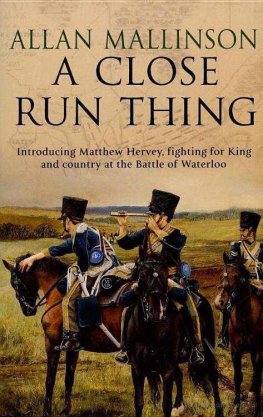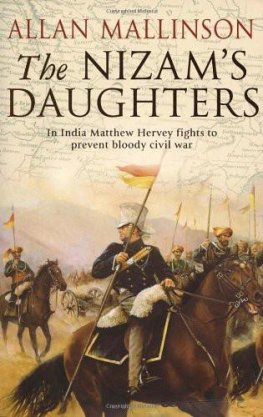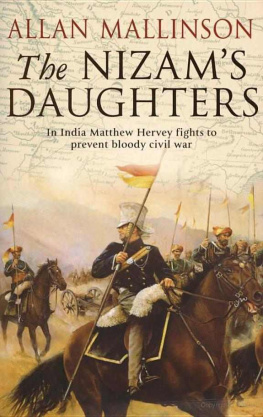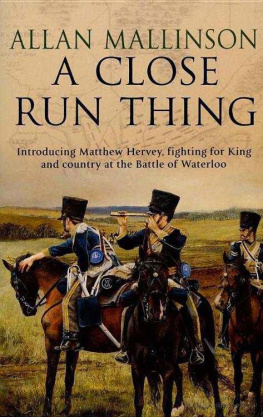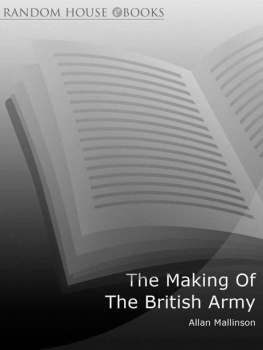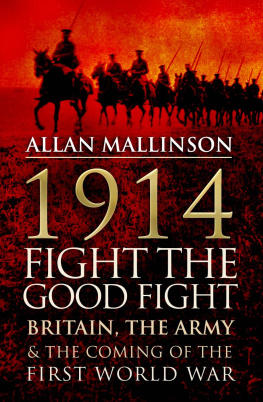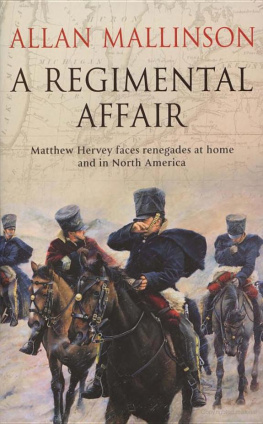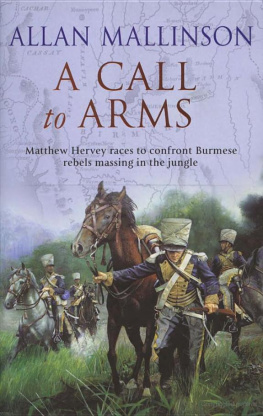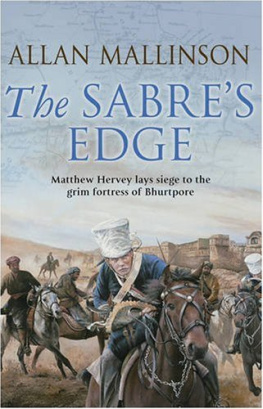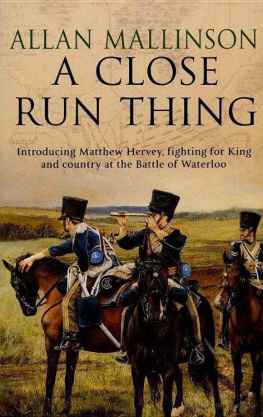Allan Mallinson - A Close Run Thing
Here you can read online Allan Mallinson - A Close Run Thing full text of the book (entire story) in english for free. Download pdf and epub, get meaning, cover and reviews about this ebook. year: 1998, publisher: BANTAM PRESS, genre: Adventure. Description of the work, (preface) as well as reviews are available. Best literature library LitArk.com created for fans of good reading and offers a wide selection of genres:
Romance novel
Science fiction
Adventure
Detective
Science
History
Home and family
Prose
Art
Politics
Computer
Non-fiction
Religion
Business
Children
Humor
Choose a favorite category and find really read worthwhile books. Enjoy immersion in the world of imagination, feel the emotions of the characters or learn something new for yourself, make an fascinating discovery.
- Book:A Close Run Thing
- Author:
- Publisher:BANTAM PRESS
- Genre:
- Year:1998
- ISBN:9780553507133
- Rating:4 / 5
- Favourites:Add to favourites
- Your mark:
- 80
- 1
- 2
- 3
- 4
- 5
A Close Run Thing: summary, description and annotation
We offer to read an annotation, description, summary or preface (depends on what the author of the book "A Close Run Thing" wrote himself). If you haven't found the necessary information about the book — write in the comments, we will try to find it.
A Close Run Thing — read online for free the complete book (whole text) full work
Below is the text of the book, divided by pages. System saving the place of the last page read, allows you to conveniently read the book "A Close Run Thing" online for free, without having to search again every time where you left off. Put a bookmark, and you can go to the page where you finished reading at any time.
Font size:
Interval:
Bookmark:
ALLAN MALLINSON
A CLOSE RUN THING
To
The Light Dragoons
(formerly the 13th/18th and the 15th/19th Hussars)
In whose history, character and personalities I have
found much inspiration for this story.
AUTHORS NOTE
This is not just the story of an officer in the Duke of Wellingtons army: it is the story of a regiment that peculiarly British institution which John Keegan, the most percipient historian and observer of all things military, has described as an accidental act of genius. Every regiment was still is different, and revelled in that difference. The difference was not just in the people but in the regiments history and traditions the received notions of how things should be done, the esprit, the spirit.
The 6th Light Dragoons are a fictitious regiment, but the events in which they take part are historical fact. The major characters outside the regiment are real figures of history. Occasional liberties have been taken General Slade did not go to Ireland in 1814, for instance but not in any way that changes the historical plausibility of the story.
The army of 1814 was singular. It had endured five years of campaigning in the Peninsula, and it had gone from success to success, until the duke was able to remark, famously, that it could go anywhere and do anything. Sir Charles Oman, one of the two greatest historians of the campaign (the other being Sir William Napier), made also this interesting observation: A very appreciable number of men were of a religious turn a thing I imagine to have been most unusual in the army of the eighteenth century. (Wellingtons Army, 18091814.)
The army was not, of course, without its faults. Neither was the duke. One of the most controversial matters was the purchase of commissions, the system by which officers of the cavalry and the infantry bought their promotion, a system that the duke strenuously upheld long after the war. This is a complex issue, however, and not one to be taken at face value. I know of no better (or more entertaining) explanation of it than that in Volume One of the Marquess of Angleseys History of the British Cavalry 18161919, which, incidentally, is also the most readable authority on horse-soldiering in the early nineteenth century.
Readers who wish to know more about the organization and equipment of the army at this time should consult the detailed reference works by Mr Philip Haythornthwaite: they have no equal. I am indebted, too, to Major (retd) John Oldfield, sometime curator of the Small Arms Museum at the School of Infantry, Warminster. The museum is an unrivalled collection of both weapons and knowledge, and (though the fact is little known) is open to visitors, by appointment. My wife, whom I met in a stable, has been an unfailing aid in finding the right words to describe the horses and their world: she has kept me from the worst metaphorical falls.
Any Englishman writing even a little about Ireland needs an Irish interlocutor of exceptional patience. I have been immensely fortunate in the friendship and support of Brigadier-General (retd) Pat Hogan, late of the Irish Defence Forces and president of the Irish Military History Society. But he can in no way be held responsible for anything that smacks of perfide Albion.
I owe a very great deal indeed to Mr Patrick OBrian directly and indirectly. His Aubrey/Maturin stories enthralled me for so many years that I began to fret for anything remotely comparable for the cavalry of that period, until eventually I found the resolve to attempt, myself, to do something about it. He has been most generous in giving me advice and encouragement.
I must acknowledge perhaps my greatest debt, however, to Paula Levey (Mrs Piers Fletcher) soldiers daughter, soldiers sister, and wife of a former soldier, who, as editor of the early manuscript, knew exactly what was what, and never flinched from telling me.
A CLOSE RUN THINGOh! pity the condition of man, gracious God! and save us from such a system of malevolence, in which all our old and venerated prejudices are to be done away, and by which we are taught to consider war as the natural state of man, and peace but as a dangerous and difficult extremity. Sir, this temper must be corrected. It is a diabolical spirit and would lead to interminable war At what time did we ever profit by obstinately persevering in war?
Charles James Fox, to the House of Commons,
3 February 1800
1814Britain had persevered in war with revolutionary France, with but one short break, since 1793. The Royal Navy, at Aboukir in 1798 and Trafalgar in 1805, had confined Bonaparte to Europe; British money had financed the allies when they were ready to come forward; and a British army in the Iberian peninsula had, from 1809, maintained a front which had drained French resources and given hope to other Europeans. By the beginning of 1814, Bonaparte could defend only France. Russian, Prussian and Austrian armies were closing in from the east, while the British, already in the Pyrenees, stood ready to invade from the south-west.
PART ONE. PRIDE AND PREJUDICE
But if you cannot make peace with Buonaparte in the winter, we must run at him in the spring.
The Marquess (later the Duke) of Wellington to the Cabinet,
10 January 1814
CHAPTER ONE. IN THE HEAT OF BATTLE
The Convent of St Mary of Magdala,
Toulouse, 12 April 1814
It is a very singular thing indeed, Mr Hervey, for a cornet to be placed in arrest upon the field of battle.
Joseph Edmonds was deploying all his considerable facility with words in order to convey the gravity of the matter at hand.
Tell me, if you please, precisely and dispassionately, the circumstances by which this was brought about.
Cornet Hervey stood rigidly to attention before the majors desk, his left hand clasping the sword scabbard to his side, his right hand clenched with the thumb pointing downwards along the double yellow stripe of his overalls. His eyes were set front, and filling the limited arc of their fixed gaze were two symbols which, while if not to his mind entirely contradictory, in their juxtaposition seemed somehow incongruous. For on the wall behind the desk was a large wooden cross with a painted figure of the crucified Christ. Next to it perhaps even leaning against it was the regimental guidon, a piece of red silk on a beechwood stave, its richly embroidered battle honours still resplendent despite the staining and fading. The irony, that he had been raised in a household whose world was shaped by the first symbol, and had then elected to throw himself wholeheartedly behind the second, was not lost on him even at this exigent moment. He had little imagined such a convergence, however, nor its place a nunnery hastily and rudely requisitioned for the purposes of the military. He drew in a deep breath, his stomach feeling tighter than ever it had done when he had been awaiting combat, and began the recollection of the events which had brought him now before his commanding officer.
Sir, yesterday forenoon I was in command of the flank picket, as you had placed me, one quarter of a league to the west of our lines of attack upon this city
The fateful encounter with authority had begun spectacularly. Edmonds had not expected any affair on the left flank. Not that that was why he had entrusted the picket to Hervey: he had long been of the conviction that the worst that could happen in battle usually did (and as a consequence he had never been wrong-footed at least, that is, in the field), and Hervey and his standing patrol were a trusty yet economical insurance.
Hervey had disposed his command, a half-troop (by the Sixths depleted muster scarcely two dozen men), in the dead ground to the rear of a shallow ridge running obliquely to the armys front. They were dismounted and standing easy. Posted as vidette a furlong to their front, with a view into the valley beyond the ridge, was his picket Serjeant. And it was the sudden animation in that sentinel that alerted Hervey now.
Font size:
Interval:
Bookmark:
Similar books «A Close Run Thing»
Look at similar books to A Close Run Thing. We have selected literature similar in name and meaning in the hope of providing readers with more options to find new, interesting, not yet read works.
Discussion, reviews of the book A Close Run Thing and just readers' own opinions. Leave your comments, write what you think about the work, its meaning or the main characters. Specify what exactly you liked and what you didn't like, and why you think so.

